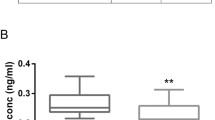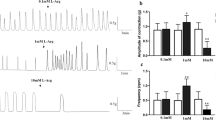Abstract
Ginger (rhizome of Zingiber officinale Roscoe) is an herbal medicine for the treatment of gastrointestinal disorders including constipation and diarrhea. Zingerone is a likely active constituent responsible for the antidiarrheal activity of ginger. The current study was designed to characterize pharmacological actions of zingerone on colonic motility. To evaluate pharmacological effects of zingerone on colonic motility, we used isolated colonic segments from rats, in which mechanical responses were recorded in the longitudinal direction. In addition, we evaluated the effects on colonic motility in vivo by measuring intraluminal pressure changes and expelled fluid volume from the colon in anesthetized rats. Zingerone was applied to the lumen of the colon to allow the drug to access from the mucosal side. Zingerone inhibited spontaneous contractile movements in the isolated colonic segments in a dose-dependent manner. The inhibitory effects of zingerone on colonic movements were not affected by pretreatment with capsazepine, a typical antagonist of transient receptor potential vanilloid 1. In addition, tetrodotoxin, a blocker of voltage-dependent sodium channels on neurons, did not affect the suppression of colonic movements by zingerone, suggesting that zingerone acts on the smooth muscles directly. Zingerone also attenuated colonic motility in vivo without affecting blood pressure and heart rate. The effects were reversible and reproducible. Our findings suggest that zingerone can inhibit colonic motility via direct action on smooth muscles. Zingerone might exert beneficial therapeutic effects on hypermotility-induced diarrhea by abrogating excessive gastrointestinal motility.




Similar content being viewed by others
References
Mascolo N, Jain R, Jain SC, Capasso F (1989) Ethnopharmacologic investigation of ginger (Zingiber officinale). J Ethnopharmacol 27:129–140
Langner E, Greifenberg S, Gruenwald J (1998) Ginger: history and use. Adv Ther 15:25–44
Langmead L, Rampton DS (2001) Review article: herbal treatment in gastrointestinal and liver disease—benefits and dangers. Aliment Pharmacol Ther 15:1239–1252
Ghayur MN, Gilani AH (2005) Pharmacological basis for the medicinal use of ginger in gastrointestinal disorders. Dig Dis Sci 50:1889–1897
Shukla Y, Singh M (2007) Cancer preventive properties of ginger: a brief review. Food Chem Toxicol 45:683–690
Ali BH, Blunden G, Tanira MO, Nemmar A (2008) Some phytochemical, pharmacological and toxicological properties of ginger (Zingiber officinale Roscoe): a review of recent research. Food Chem Toxicol 46:409–420
Govindarajan VS (1982) Ginger—chemistry, technology, and quality evaluation. Part 1. Crit Rev Food Sci Nutr 17:1–96
Vriens J, Nilius B, Vennekens R (2008) Herbal compounds and toxins modulating TRP channels. Curr Neuropharmacol 6:79–96
Chen JC, Huang LJ, Wu SL, Kuo SC, Ho TY, Hsiang CY (2007) Ginger and its bioactive component inhibit enterotoxigenic Escherichia coli heat-labile enterotoxin-induced diarrhea in mice. J Agric Food Chem 55:8390–8397
Kunzelmann K, Mall M (2002) Electrolyte transport in the mammalian colon: mechanisms and implications for disease. Physiol Rev 82:245–289
Fondacaro JD (1986) Intestinal ion transport and diarrheal disease. Am J Physiol 250:G1–G8
Tortoriello J, Aguilar-Santamaria L (1996) Evaluation of the calcium-antagonist, antidiarrhoeic and central nervous system activities of Baccharis serraefolia. J Ethnopharmacol 53:157–163
Vitali F, Fonte G, Saija A, Tita B (2006) Inhibition of intestinal motility and secretion by extracts of Epilobium spp. in mice. J Ethnopharmacol 107:342–348
Poonia BS, Sasmal D, Mazumdar PM (2007) Anti-diarrheal activity of methanol extract of Litsea polyantha bark in mice. Fitoterapia 78:171–174
Borrelli F, Capasso R, Pinto A, Izzo AA (2004) Inhibitory effect of ginger (Zingiber officinale) on rat ileal motility in vitro. Life Sci 74:2889–2896
Tulimat MA, Ishiguchi T, Kurosawa S, Nakamura T, Takahashi T (2001) The inhibitory effect of herbal medicine Dai Kenchu To (DKT) on the colonic motility in rats in vitro. Am J Chin Med 29:111–118
Szallasi A, Blumberg PM (1999) Vanilloid (Capsaicin) receptors and mechanisms. Pharmacol Rev 51:159–212
Szolcsanyi J, Bartho L (2001) Capsaicin-sensitive afferents and their role in gastroprotection: an update. J Physiol Paris 95:181–188
Liu L, Welch JM, Erickson RP, Reinhart PH, Simon SA (2000) Different responses to repeated applications of zingerone in behavioral studies, recordings from intact and cultured TG neurons, and from VR1 receptors. Physiol Behav 69:177–186
Bossone C, Hosseini JM, Pineiro-Carrero V, Shea-Donohue T (2001) Alterations in spontaneous contractions in vitro after repeated inflammation of rat distal colon. Am J Physiol Gastrointest Liver Physiol 280:G949–G957
Toda N, Herman AG (2005) Gastrointestinal function regulation by nitrergic efferent nerves. Pharmacol Rev 57:315–338
Takaki M, Jin JG, Lu YF, Nakayama S (1990) Effects of piperine on the motility of the isolated guinea-pig ileum: comparison with capsaicin. Eur J Pharmacol 186:71–77
Mino T, Yuasa U, Nakamura F, Naka M, Tanaka T (1998) Two distinct actin-binding sites of smooth muscle calponin. Eur J Biochem 251:262–268
Sim JH, Kim YC, Kim SJ, Lee SJ, Suh SH, Jun JY, So I, Kim KW (2001) Capsaicin inhibits the voltage-operated calcium channels intracellularly in the antral circular myocytes of guinea-pig stomach. Life Sci 68:2347–2360
Fujimoto S, Mori M (2004) Characterization of capsaicin-induced, capsazepine insensitive relaxation of ileal smooth muscle of rats. Eur J Pharmacol 487:175–182
Fujimoto S, Mori M, Tsushima H, Kunimatsu M (2006) Capsaicin-induced, capsazepine-insensitive relaxation of the guinea-pig ileum. Eur J Pharmacol 530:144–151
Dunn WR, Hardy TA, Brock JA (2003) Electrophysiological effects of activating the peptidergic primary afferent innervation of rat mesenteric arteries. Br J Pharmacol 140:231–238
Matsumoto K, Kurosawa E, Terui H, Hosoya T, Tashima K, Murayama T, Priestley JV, Horie S (2009) Localization of TRPV1 and contractile effect of capsaicin in mouse large intestine: high abundance and sensitivity in rectum and distal colon. Am J Physiol Gastrointest Liver Physiol 297:G348–G360
Liu L, Simon SA (1996) Similarities and differences in the currents activated by capsaicin, piperine, and zingerone in rat trigeminal ganglion cells. J Neurophysiol 76:1858–1869
Theodorou V, Fioramonti J, Hachet T, Bueno L (1991) Absorptive and motor components of the antidiarrhoeal action of loperamide: an in vivo study in pigs. Gut 32:1355–1359
Ogata N, Ataka K, Morino H, Shibata T (1999) Effect of wood creosote and loperamide on propulsive motility of mouse colon and small intestine. Pharmacology 59:212–220
Kuge T, Venkova K, Greenwood-Van Meerveld B (2001) In vitro effects of wood creosote on enterotoxin-induced secretion measured electrophysiologically in the rat jejunum and colon. Biol Pharm Bull 24:623–627
Johanson JF (2004) Options for patients with irritable bowel syndrome: contrasting traditional and novel serotonergic therapies. Neurogastroenterol Motil 16:701–711
Holzer P (2009) Opioid receptors in the gastrointestinal tract. Regul Pept 155:11–17
Muramatsu I, Fujiwara M, Shikimi T, Nakashima M (1979) Effects of loperamide on the guinea pig taenia coli. Eur J Pharmacol 55:181–187
Morino H, Ataka K, Ito M, Kuge T (2004) Wood creosote inhibits calcium mobilization in Guinea pig colonic smooth muscle. Biol Pharm Bull 27:1046–1051
Acknowledgments
We are grateful to Kanebo Institute for the kind gift of zingerone. This work was supported in part by Grants-In-Aid for Scientific Research from the Ministry of Education, Culture, Sports, Science, and Technology of Japan.
Author information
Authors and Affiliations
Corresponding author
Rights and permissions
About this article
Cite this article
Iwami, M., Shiina, T., Hirayama, H. et al. Inhibitory effects of zingerone, a pungent component of Zingiber officinale Roscoe, on colonic motility in rats. J Nat Med 65, 89–94 (2011). https://doi.org/10.1007/s11418-010-0463-0
Received:
Accepted:
Published:
Issue Date:
DOI: https://doi.org/10.1007/s11418-010-0463-0




